Laptop Mag Verdict
The second-generation Eee PC is worth the extra money because of its larger screen and beefier storage, but we wish it lasted longer on a charge.
Pros
- +
Wider, higher-resolution screen
- +
Multi-touch trackpad
- +
Simple interface
- +
Lightweight design
Cons
- -
Cramped keyboard
- -
Lackluster battery life
- -
Automatic power-saving feature affects performance
Why you can trust Laptop Mag
ASUS pioneered the low-cost laptop frontier with its Eee PC 701. This trailblazer, now competing against more polished competition such as HP's Mini-Note, seeks to maintain its lead with the Eee PC 900. This $549 mini-notebook addresses its predecessor's drawbacks by including a larger, higher-resolution 8.9-inch screen and more storage space.
We tested the Linux-based version, which comes with a 20GB solid state drive. (A Windows XP version of the 900 will also be available for $549 but it will sport a smaller 12GB SSD). Add in an improved 1.3-megapixel webcam and a multi-touch capable touchpad, and you have the makings of a successful, albeit more expensive sequel. If you can live with shorter battery life and a still-small keyboard, the Eee PC 900 is worth the extra dough.
Similar Design, Size, and Weight
Aesthetically, the Eee PC 900 isn't noticeably different from the Eee PC 701 (or Eee PC 4G); the two look almost identical when sitting side by side. The systems, however, are more fraternal than identical twins: The Eee PC 900 is 0.2 inches longer than its brother and approximately 3.2 ounces heavier. Nevertheless, the system is still no bigger than most hardcover books, and carrying it around in a shoulder bag still left ample room for a wallet, keys, and cell phone. Under the lid we instantly noticed a few key differences. The screen is almost 2 inches larger (more on that below), the speakers that straddled it have been moved to the underside, and a silver plate surrounds the webcam.
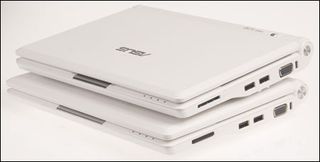
Click to enlarge
ASUS didn't change the port configuration on the Eee PC 900; it comes with headphone and microphone jacks, an Ethernet connection, an SD/MMC card reader, and three USB ports. There's also a VGA output for connecting to an external display.
Cramped Keyboard, Expanded Touchpad
In order to maintain its minuscule dimensions, ASUS left the tight keyboard intact. The tiny keys are no bigger than Chiclets, and the cramped layout takes practice to build up a decent typing speed. We much prefer the HP Mini-Note's 92 percent-size keyboard, which is very comfortable. We had no problem, however, attaching a USB Logitech keyboard to the Eee PC 900 for long typing stints.
Measuring 2.5 x 1.5 inches, the trackpad on the Eee PC 900 feels like a king-size bed compared with the one found on the 701 or 4G. The wider and more spacious pad requires less backtracking and is made for more accurate controlling of the screen. ASUS also extended the single silver bar that serves as a left and right mouse button; a divot separates the right from the left, but the uniform button still feels mushy and requires a firm press. We would prefer two dedicated buttons with more tactile response.

Click to enlarge
The trackpad's standout feature is ASUS' new multi-touch FingerGlide capability. Similar to the Apple MacBook Air's touchpad, we could scroll vertically through Web pages by swiping two fingers up or down; scrolling horizontally was finicky. You can zoom in on pictures or documents by pinching and zoom out by spreading two fingers apart. However, we weren't able to rotate a picture or move through multiple pictures or Web pages with quick finger gestures.
Sweet Display, Decent Speakers
The 8.9-inch matte display with a native resolution of 1024 x 600 pixels is much easier on the eyes than the previous version's 7-inch, 800 x 480-pixel resolution. Web pages fit well on the screen and required little to no horizontal scrolling. Nor did program windows need to be resized to fit the screen, and we were even able to keep the music player open alongside a document in OpenOffice.
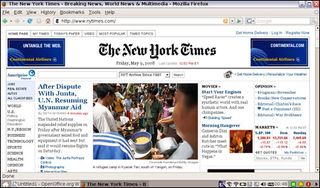
Click to enlarge
We were impressed when we watched a Windows Media Video file of Raiders of the Lost Ark; it wasn't exactly high definition, but Harrison Ford and the tropical scenery came through very clearly. Vertical viewing angles were poor; simply tilting the screen caused a glare. We also noticed a bit of motion blur during action-packed scenes, but that's to be expected with such modest components.
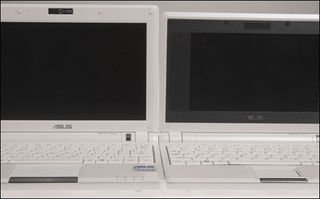
Click to enlarge
The speakers, which have been moved from the sides of the screen to the bottom of the system, still produce loud and steady sound; we didn't have a problem hearing our callers or Harrison Ford's voice when watching Raiders.
Improved Video Chats
The integrated 1.3-megapixel webcam, which is an upgrade from the VGA camera on the original system, worked well in a Skype video chat, but our caller reported that the image quality was on the grainy side. Still shots, however, came out clearly with little fade or overexposure. The microphone, which is located to the right of the webcam, picked up some background noise during a Skype call, but our caller could hear us well without having us speak up.
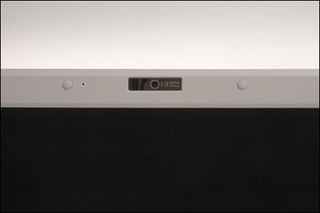
Click to enlarge
Eee PC 900 Performance
The Eee PC 900 uses the same 900-MHz Intel Celeron processor as the 701, but it comes with 1GB of RAM, up from 512MB. ASUS plans to incorporate Intel's Atom processor in later iterations of the system, but we found the Intel Celeron processor up to snuff. The Eee PC 900 had no trouble running multiple applications, and programs loaded quickly even when we had several others running in the background. (Keep in mind that we were testing the Linux version of the Eee PC 900; we'll bring you a full review of the XP version shortly.) We were able to listen to music, have a video conference with a friend, surf the Web, and write this review in OpenOffice Writer all at the same time with no hang-ups.
We continue to appreciate the speed and durability of the solid state drive, and ASUS provides a lot more space on the Eee PC 900: 20GB, or five times the capacity of the drives on earlier models. Plus, the system boots in a quick 26 seconds.
Good Wi-Fi Range
The Eee PC 900's 802.11 b/g Wi-Fi connected easily to our WPA-protected access point. It never dipped below 86 percent signal strength in a 50-foot radius, and we experienced no dropped connections. Web pages loaded quickly on our office network; NYtimes.com loaded in 2 seconds. We also had no problem streaming video from Hulu.com and YouTube. An episode of 30 Rock had minimal video pauses and audio skips.
Shorter Endurance
We managed to get 2 hours and 18 minutes of juice out of the battery before needing a charge. That isn't as impressive as the Eee PC 4G's 3.5 hours, but it isn't surprising, considering the larger screen uses more power. One peeve is that when the AC adapter is unplugged, the Eee PC 900 immediately enters a power-saving mode, which lowers the already slow CPU speed. We also noticed that the system didn't handle video as well as it did when it was plugged in; there were more pauses and skips.
Excellent Interface and Software

Click to enlargeASUS wisely decided not to tinker with its intuitive user interface, which hides the Xandros-based Linux operating system. This only-what-you-need desktop is also refreshingly free of clutter and bloatware. Six straightforward tabs (Internet, Work, Learn, Play, Settings, and Favorites) offer fast access to some rich applications, including OpenOffice, Pidgin, Skype, Thunderbird, Wikipedia, and quick links to the most popular Web-based e-mail services. ASUS also tosses in a handful of edutainment games starring the Linux penguin.
Adding programs remains a challenge, which is why we recommend the XP version of the Eee PC 900 for those who want to run Windows applications. The Eee PC 900 comes with a one-year warranty covering parts and labor and six months of coverage for the battery.
Verdict
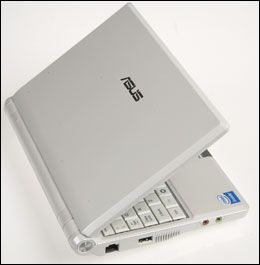
Click to enlarge
The Linux-powered ASUS Eee PC 900 markedly improves on an already solid mini-notebook. Though the system is $150 more than its predecessor and has an hour less of battery life, those longing for an ultra-mobile system that sports a larger screen and more storage space will find the Eee PC 900 attractive. The HP 2133 Mini-Note PC offers a better keyboard and longer endurance (with the six-cell battery), but its Linux OS isn't as user-friendly, and the Windows Vista version we liked costs $750. Despite some weaknesses, we recommend the Eee PC 900 as a secondary PC.
ASUS Eee PC 900 (Linux) Specs
| Brand | ASUS |
| CPU | 900-MHz Intel Celeron |
| Company Website | http://usa.asus.com |
| Display Size | 8.9 |
| Graphics Card | Integrated graphics |
| Hard Drive Type | SSD Drive |
| Native Resolution | 1024x600 |
| Ports (excluding USB) | VGA, Microphone, Headphone, Ethernet |
| RAM | 1GB |
| RAM Upgradable to | 1 GB |
| Size | 8.9 x 6.7 x 1.3 inches |
| USB Ports | 3 |
| Video Memory | 64MB |
| Warranty/Support | One-year limited, six months for battery/24/7 toll-free phon |
| Weight | 2.2 pounds |
| Wi-Fi | 802.11b/g |
